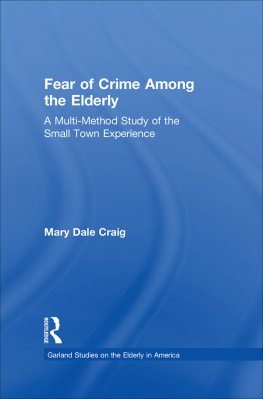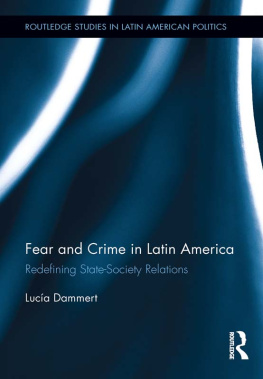Inventing Fear of Crime
Inventing Fear of Crime
Criminology and the politics of anxiety
Murray Lee
First published by Willan Publishing 2007
This edition published by Routledge 2011
2 Park Square, Milton Park, Abingdon, Oxon OX14 4RN
711 Third Avenue, New York, NY 10017
Routledge is an imprint of the Taylor & Francis Group
2007 Murray Lee
The rights of Murray Lee to be identified as the author of this book have been asserted by him in accordance with the Copyright, Designs and Patents Act of 1988.
All rights reserved; no part of this publication may be reproduced, stored in a retrieval system, or transmitted in any form or by any means, electronic, mechanical, photocopying, recording or otherwise without the prior written permission of the Publishers or a licence permitting copying in the UK issued by the Copyright Licensing Agency Ltd, 90 Tottenham Court Road, London W1P 9HE.
Hardback
ISBN 978 1-84392-175-2
Paperback
ISBN 978 1-84392-174-5
British Library Cataloguing-in-Publication Data
A catalogue record for this book is available from the British Library
Project managed by Deer Park Productions, Tavistock, Devon
Typeset by GCS, Leighton Buzzard, Bedfordshire, LU7 1AR
Contents
4 Surveying the fearful: the international expansion of the victim survey
7 Consuming fear: the marketing (of) monsters
Acknowledgements
The writing of this book has been a labour that goes back some 10 years. No doubt in that time the work has become a collective effort to the point that it is difficult to acknowledge the input of every individual colleague, friend and family member. Thanks to the efforts and patience of all who contributed their time, ideas and emotional support, and apologies to anybody I have forgotten to mention.
Without the early guidance of Kerry Carrington and Russell Hogg this project would never have been undertaken. Their feedback and input into early versions of what became this text helped etch its intellectual terrain and give it its critical focus. I remain indebted to their commitment. I also want to acknowledge the early inspiration provided by Andrew Johnson whose friendship and collegiality were greatly appreciated as this project took shape. Likewise, I greatly appreciate the constructive feedback on earlier versions of this text provided at various times by John Pratt and Tony Jefferson.
This book would not have been written without the enthusiastic prompting of Stephen Farrall. His feedback on earlier concepts and ideas remain central to the book. I also acknowledge the increased match fitness provided by Stephens guided mountain bike tours through the wilds of North-East Wales and the Peak District on my visit to Keele University in 2005.
Likewise, Jason Ditton and Furzana Khan provided me with astute advice, ideas and feedback on a visit to Glasgow while researching this book. Im particularly indebted to Jason for his hospitality and whistle-stop tour of the Glaswegian crime sights. Gabe Mythen also proved a most hospitable intellectual sounding board on a brief visit to Manchester though no doubt his backhand could do with some work before our next court visit. Reece Walters, Keith Soothill and Shadd Maruna, as peer reviewers of the original proposal for this book, provided valuable and constructive feedback which Ive attempted to incorporate. I hope the finished product measures up to expectations. Thanks to Brian Willan who has not only had faith in the project but who patiently awaited the arrival of the manuscript well after the due date.
Kelly Richards, John Gaffey, Alyce McGovern and Lynette Aitken have all worked on research projects related to this book. Their efforts are greatly appreciated. My colleagues Denise Weelands, Moira Carmody, Elaine Fishwick, Adam Possamai, Leanne Weber and Craig Osmond have all provided me with inspiration and support over the period of writing this book. I am additionally grateful to Craig and Elaine for providing feedback on chapters herein. My great friends from Ancient Marinators Mark, Bruce, Tom and Adam provide me with a weekly reality (or perhaps hyper-reality) check without which I would probably go clinically insane, although Id sleep easy in the knowledge that categories of insanity are simply constructs of the knowledge/power of the psych-sciences, being a good Foucaultian.
I would additionally like to thank Mark Hetherington for allowing me to use his wonderful painting The Fear of Crime on the cover. Marks work can be viewed online at the Ray Hughes Gallery http://www.rayhughesgallery.com
My parents Beth and Brian Lee and my grandparents Alice and Arthur Billett have furnished me with ongoing love in life and support in my work. I remain indebted to them. I was fortunate to grow up at a point in history when a working-class kid from the suburbs of Newcastle NSW could make it into a university albeit as a mature student with a bit of life experience. As we continue down the inevitable, we are told road of user pays education in Australia such opportunities are quickly evaporating. If I were starting my journey now I fear I would never have made it through the gates of a university let alone be set loose to teach and research in one.
Wendy Lee has supported me in my work and my life in ways too numerous to detail. The book would not have been written without her. Nor would I have made it to the end without the support and patience of our children Manon and Tate. Perhaps Manon was right when she said, Dad, why didnt you just write a little kids book? Anyway, if there are any publishers out there Ive got an idea about a dinosaur and a lion scared of becoming victims of crime. The lion says to the dinosaur, Would you feel safe in the park after dark?, and the dinosaur replies, I dont really go out in the dark to the park. But perhaps its time to move on, I might get stuck in a rut. And anyway, the thought of writing a childrens book terrifies me, they are always the most insightful and rigorous of critics.
Murray Lee
Chapter 1
Introduction
There is an almost endless number of still-to-be written histories of concept formation in criminology: Concepts that were invented in this culture, by thinkers in those strata, in that period of time, for these reasons, and with those effects. (Beirne 1993: 9)
This is a book about a concept, its formation and its effects. The concept under discussion here is fear of crime. This is a history of how fear of crime has been problematised and pathologised, how it has assumed an empirical validity and a social scientific respectability, and how it became normalised as a socio-cultural term used to describe an element of life experience in late modernity. Piers Beirne notes in the introduction to his book Inventing Criminology: Essays on the Rise of Homo Criminalis (1993), from which I have paraphrased the title of this book, that there are an almost endless number of histories of criminological concepts to be written. This book constitutes one such history.
Over the past four decades the fear of crime has become an increasingly significant concern for criminologists, victimologists, policy-makers, politicians, policing organisations, the media and the general public. Growing interest in the fear of crime problem from policy-makers across the political spectrum (Reiner






